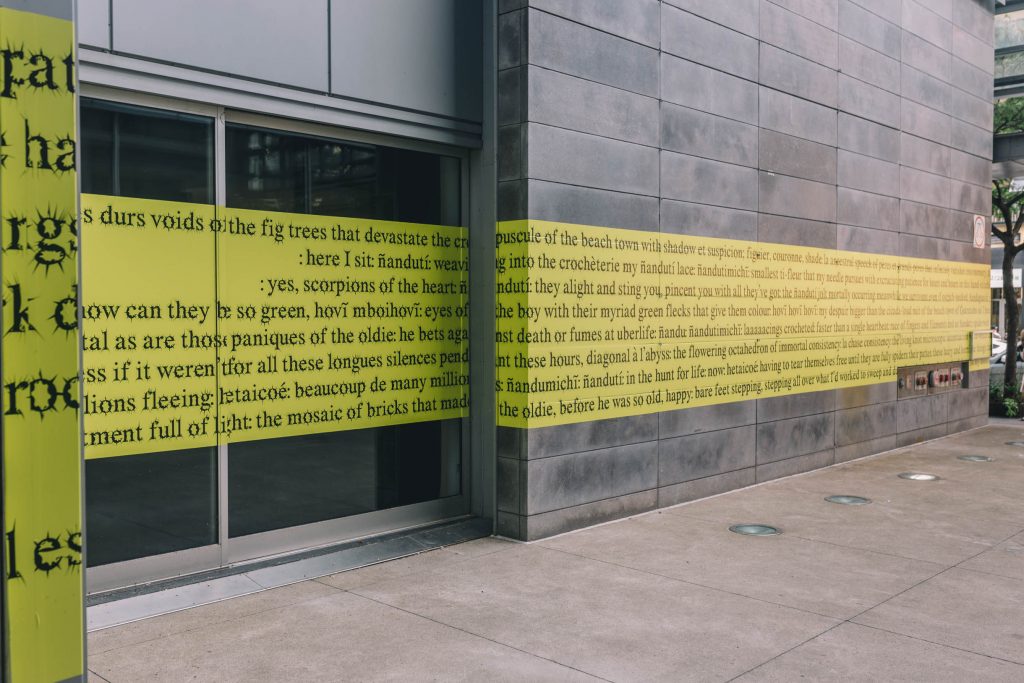Experience four distinct installations in the FOFA Gallery’s La Rentrée
Like reading through someone’s journal or overlapping streams of thought, the Faculty of Fine Arts (FOFA) Gallery welcomes students back to school with La Rentrée, featuring the work of four Concordia artists and a local poet in four distinct installations.
Corina Kennedy, a graduate of Concordia’s studio arts program, contributed her piece, titled Tender for All. It features carved characters that mimic the way lettering is traditionally carved into the marble walls of old-fashioned banks. The artist explores “limited, disjointed and repetitive language” in an imitation of the way debt collectors communicate with their clients. Kennedy’s insulation foam installation is massive, occupying the entirety of the York Corridor Vitrine, by the entrance of the gallery.
After having shown Tender for All in a studio space in New York, Kennedy found that tailoring the insulation foam to fit the York Corridor Vitrine was a new challenge. “The sheer length and foot traffic around it is gratifying enough,” Kennedy said. “But seeing it behind that glass is really delighting [to] me because insulation foam is something that is supposed to get hidden behind a wall. So the glass is just the opposite of that.”
Since graduating in 2007, Kennedy has accumulated her share of student debt, so she wanted to express the stress associated with that. She added that the struggles of “many viewers […] with student debt” may be reflected in this work. The artist imagined passersby will only stop at her piece for a moment before moving on, because so many people put off confronting their debt.
Inside the gallery, Concordia painting and drawing professor Adrian Norvid’s collection of drawings and paper sculptures dominate the space. Sprawled across the walls, The Bejesus explores Norvid’s thought process during his creative endeavours in a crude, comical way. His other piece, The Black Bumhole Opera is at the centre of the installation, and explores the “dirty” and “grimey” culture surrounding heavy metal music.
In a separate room from Norvid’s display, Erin Weisgerber’s piece, Minerva’s Owl, explores a variety of film processes. By capturing New York’s Kodak tower through three different types of film, the Concordia graduate intended to show her viewers a raw, playful approach to cinematography. One example of this is Weisgerber’s decision to keep all glitches with the camera and film in the piece. The film loops through cycles of day and night, which are projected onto a wall. The space between the projector and the wall is divided by three mesh screens, enabling the viewer to walk between them and experience the different film techniques to interpret the piece.
Outside the gallery and spanning the facade of the Engineering and Visual Arts (EV) building is Andrew Forster, a part-time studio arts teacher, and Erín Moure’s contribution. Paraguayan Sea presents an excerpt of Brazilian writer Wilson Bueno’s book of the same name. The large, yellow banner of text stretches across the outside of the building, catching the viewer’s eye as they walk past.

Bueno’s original text was written in three languages: Portuguese, Spanish and Guaraní. Moure, a local poet and translator, incorporated the original Guaraní text into the piece and translated the Portuguese and Spanish parts into English and French. By doing so, not only did Moure make this beautiful text available for English and French speakers, but she also emphasized the diverse cultures within Montreal.
The creative process behind the project was twofold; Moure provided the translation of the text while Forster designed the final product. In his colleague’s words, Forster became “intrigued by the text and by the nature of a polylingual text as ‘skin.’” Forster then took this idea and decided to bring it to the public by “laminating it to architecture.”
Paraguayan Sea interrupts the noisy advertisements on Ste-Catherine Street and explores public speaking, surface, depth and the utility of art in a public space. The text itself has been described by the artists as “a murmur heard in the streets of a city at all times.” The translated version of Paraguayan Sea has been published and will be available for purchase at the FOFA Gallery on Nov. 9 during a discussion panel of the artists’ work. Both Forster and Moure will be present at the event.
The indoor exhibitions at the FOFA Gallery are open Monday to Friday from 11 a.m. to 6 p.m. until Oct. 20. Paraguayan Sea is open 24 hours and will be up until Dec. 8. Admission is free.
Feature photo by Kirubel Mehari




